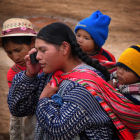
Mobile learning has had a positive impact on education in Latin America
Puentes Educativos
Using mobile phones in education is a growing trend, but there are challenges to making it sustainable, finds Paula Leighton.
[SANTIAGO] While the first decade of the 21st century witnessed numerous initiatives to provide every child with access to a laptop, more recently there has been a steady increase in projects exploring the use of mobile phones for learning.
Several such projects have emerged in Latin America. But there are significant challenges to realising the full potential of their classroom applications.
Mobile learning, or 'm-learning', involves the use of standard mobile phones and smartphones, either alone or in combination with other technologies, for educational purposes.
With around six billion mobile phone subscriptions worldwide, these devices present an unprecedented opportunity to support learning in a cheaper, ubiquitous and more portable format than even low-cost computers.
Last month, the UN Educational, Scientific and Cultural Organization (UNESCO) published 12 working papers reviewing mobile learning initiatives in Africa and the Middle East, Asia, Europe, North America, and Latin America, with a view to understand better the possibilities and implications of m-learning for educational policy, and how it might support the UN's Education For All (EFA) goals.
This regional information was then synthesised into two papers with a global perspective to identify broader trends.
M-learning in Latin America
The two Latin American working papers, 'Turning on Mobile Learning in Latin America' and 'Mobile Learning for Teachers in Latin America', describe mobile learning initiatives across the region and use a survey of national and local m-learning policies to reveal how mobile phones are being used to support the work of teachers and improve their practice.
"Mobile phones are a resource already in use by a significant number of students and their teachers," Victoria Uranga, coordinator of the knowledge management section at UNESCO's regional education bureau for Latin America and the Caribbean (OREALC), tells SciDev.Net.
"The next challenge is to develop more educational applications for thistechnology," she says.
Uranga notes that the technology had tremendous potential for building "inclusiveness" in educational participation — a view shared by Ignacio Jara, co-author of 'Mobile Learning for Teachers in Latin America'.
His study described 18 m-learning initiatives in six countries. These included initiatives to enable teachers to access multimedia resources and present them to students in the classroom, to collect and share information, and to allow students to participate in collaborative activities, play educational games, reinforce key concepts and exchange information with professors and peers.
"We found a wide range of high quality, innovative and longstandinginitiatives exploring mobile learning in Latin America," he says.
"Their level of advancement was not far off what has been achieved in developed countries."
A focus on pedagogy
UNESCO has highlighted three projects, each launched between 2010 and 2011, because of their focus on specific methodologies and pedagogical practices: Puentes Educativos (Educational Bridges) in Chile, Raíces de Aprendizaje Móvil (Roots of Mobile Learning) in Colombia, and Entorno Móvil Interactivo de Aprendizaje (Mobile Learning Environment) in Argentina.

Most people in Latin America now own mobile phones
Flickr/Matt JP
The Chilean and Colombian initiatives, both developed by the international BridgeIT (a partnership to bring multimedia education programmes to schools around the world), provide biannual training for teachers to help them plan mathematics, science and English lessons using interactive and student-centred learning activities.
In these initiatives, school teachers receive a smartphone with wireless connectivity and a data projector. These allow them to download and screen educational videos that can motivate students, and highlight specific content or science experiments.
In Chile, Puentes Educativos reaches 600 teachers, who collectively teach more than 10,000 children, at 160 public schools.
"An independent assessment comparing with a control group has shown that both students and teachers taking part in the programme have higher motivation," Gonzalo Plaza, head of Puentes Educativos tells SciDev.Net.
"Children also demonstrated larger concentration spans [using this technology], making their time in class more effective."
In Argentina, EMIA-SMILE supports inquiry-based learning to improve students' writing and scientific thinking skills. Working in groups, students use smartphones connected to a local network to create, post and answer questions about specific topics.
Teachers monitor the students' activity from a laptop and use real-time feedback from students to lead class discussions.
Huge potential
According to the authors of UNESCO's 'Mobile Learning for Teachers in Latin America', these experiences and others in the region reveal that the use of mobile phones in education has the potential to make learning more accessible, collaborative and relevant.
"As a low-cost substitute for computers, mobile phones can increase access to the internet and digital educational content, and because the devices are portable, they can facilitate learning outside as well as inside schools", they say.
The penetration rate in Latin America is very high for standard mobile phones. By 2008, more than 80 per cent of 10–18 year-olds across the region owned a mobile phone, and this included teenagers in rural and impoverished communities. And unlike computers, mobiles are affordable for the majority of the region's population.
The authors note, too, that standard mobile phones "are particularly well-suited for use in rural areas, where educational resources are scarce and fixed broadband connections are unavailable or unreliable".
"Given that many teachers and students have access to mobile phones, there is an opportunity for the education system to think about how can they take advantage of an infrastructure that is already widely spread in many of the communities in which they work", Michael Trucano, senior ICT (information and communication technology) and education policy specialist at the World Bank, told SciDev.Net.
This can greatly reduce the investments required for equipment, training and technical support, Trucano adds.
While indicating significant progress, these m-learning experiences in Latin America also demonstrate challenges to the continued expansion of such projects.
Into the future

A large number of Latin American school children already benefit from 'm-learning'
Flickr/Julio Pantoja - World Bank
The UNESCO reports note that Latin America has focused heavily on the '1:1' concept, which aims to provide every student and teacher with a laptop or netbook.
This policy has been adopted by several governments, including Argentina, Brazil, Colombia, Peru, Uruguay, and Venezuela.
"Because the efforts being made to integrate ICT into education are already considerable, it is possible that some governments consider their educational ICT agenda to be saturated, and that mobile learning initiatives will need to wait until there is more 'room'," says the paper.
But Trucano says this need not be seen as a limitation to expansion — instead it is a warning against shaping projects around technology rather than around content.
"In the future, governments are going to face realities that there will be all sort of different devices being used in schools and by students," he says. "There will be traditional desktop computers, laptops, tablets, mobile phones, and a variety of other technologies".
As governments and schools try to work out how best to allocate resources, he says, "they should be thinking more broadly than just buying computers in the traditional sense".
It is a view echoed by Gonzalo Plaza, of Puentes Educativos.
"The priority for success is focusing on getting the learning methodology right, and then treating technology as complementary to that," he says.
"If you approach it from the opposite direction, the project will probably fail. And the other key focus must be strong teacher training and technical support."
Another challenge is access to mobile phone networks. While around 90 per cent of most OECD (Organisation for Economic Co-operation and Development) countries have 3G or 4G network [high-speed, reliable network] coverage, only 55 per cent in Latin America do so.
This limits opportunities for mobile learning programmes that rely on smartphones or require high-speed connectivity, and it "particularly affects isolated and rural areas", says Plaza.
A world of opportunities
Despite the barriers and challenges, experts are optimistic about the potential of mobile learning to improve and facilitate learning, especially in communities where educational opportunities are restricted.
"Mobile learning has the potential to address specific educational needs in Latin America, from increasing literacy and basic education skills for vulnerable populations to improving the administrative management of education systems," concludes the UNESCO report.
"We are still in the very early stage of activities," Trucano says, but adds that policymakers "should take [m-learning] seriously, because it is happening".
Ignacio Jara says government support is crucial to enabling the further expansion of m-learning in Latin America.
"It is possible to explore and run pilot projects without the support of [education ministries], but expansion always demands access to funding and educational policy tools, and these depend on ministry officials," he says.
Trucano agrees: "Encouraging government interest in m-technology, and developing policies around its use sends a signal to school principals and teachers that this is something viable to consider", he says.
"It also sends signals and provides direction for private industry, civil society groups, and academic groups that this is an area they probably can get involved in and help out."

mobile leads are also so much important as mobiles,You have so many option for mobile leads but this is the best way for selecting mobile leads. Thank you. Mobile Leads.
ResponderExcluir